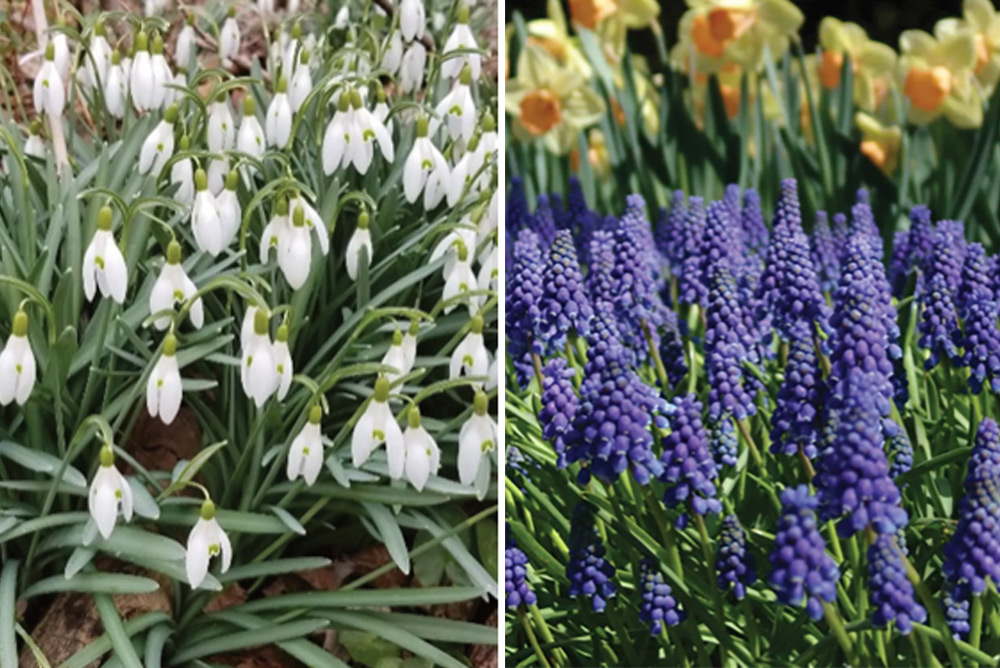
Snowdrops (Galanthus elwesii), left, and blue Muscari (grape hyacinth), right, both from the Burpee website.
By Stephanie Cavanaugh
HOW I CAN fail to see the obvious for . . . decades, I just don’t know.
It’s like my abhorrence of vegetable soup, which continued into my 30s. All those strange bits floating about: little white things, little orange bits, green murk. Anything could be hiding in there, my toddler brain was still saying.
And then I discovered the bits were barley, carrots, peas . . . vegetables. Oh.
This is how I felt wandering out to lunch today, a half-mile trek to Eastern Market to meet Maggie and split a BLT at Prego—they make it a bit too big for one person—and pick up a roast chicken at the Market so I don’t have to bother to cook tonight.
What I was noticing on the walk over was the abundance of “minor bulbs” in the mostly tiny gardens that front the row houses, here on Washington DC’s Capitol Hill. Bulbs that grow just 5 inches or so: snow drops and crocus and grape hyacinth (which you need to lie down on the ground to sniff, but it’s worth it) and candy tuft and star flowers scattered, as if tossed, ever so casually in the little plots.
These are not planted in a mass along a border or in patches, which would leave clumps of browning greens as they finish their blooming. Scattering them lets the spent flowers hide under summer plants as they leaf out.
How smart, I thought.
Oddly, with spring having come in a rush, with the Yoshino cherry trees peaking weeks before they were due, the tulips and hyacinth and even some roses already out, the daffodils have not done well at all. I think they lasted a week. Now they’re just bunches of foliage, not even attractive foliage, that one is to leave alone, allow to flop and shrivel and blacken and die while their bulbs feed like alien horrors underground, sucking up nutrients so they can emerge again next spring and once again either last a week or not.
For several years I tried ridding the yard of them, yanking what I could, throttling the rest with twine, cutting the leaves down hard. Nothing stopped them. In a small garden, they really are more of a nuisance than a pleasure. You can buy a bunch for a buck just about anywhere and pop them in a vase.
If you want them in the garden, get those little water tubes from (I promised not to say Amazon) from, I don’t know, a florist maybe—they sometimes put rose stems in them—or a craft shop like Michaels. You can take the daffs you bought and just stick them wherever—in the soil, in a window box—and yank them when they die. Clean, easy, dust off your hands. Done.
(Tip: When you have a bare patch or patches, you can do this with any flowers anytime).
These minor bulbs will just hide themselves when they’re done flowering, leaving inoffensive tufts of green that will easily hide in the groundcover, or under the hydrangea branches. And in the meantime, you have this floral carpet. In my case, they would be interspersed with vinca and its charming small purple flowers, adding texture and color.
Here’s to next year! Remind me, please.
In the meantime, enjoy your Easter.

They are pretty, but native alternatives are an important contributor that support pollinators and birds. One example, Virginia bluebells, is a beautiful spring of ephemeral. Daffodils are indeed a naturalized (they spread) non-native species and, like lawn, don’t do much for the ecosystem. Check out Doug Tallamy’s Homegrown National Park to see which “keystone” plants provide the food and habitat that Pollinators, birds and wildlife need to survive. They will make your garden come alive, unlike sterile ornamentals.
Knew you’d find/see something to inspire you on your stroll home after lunch. Always truly taken how you come up with thoughts & ideas to keep your fans amused and informed in equal measure.